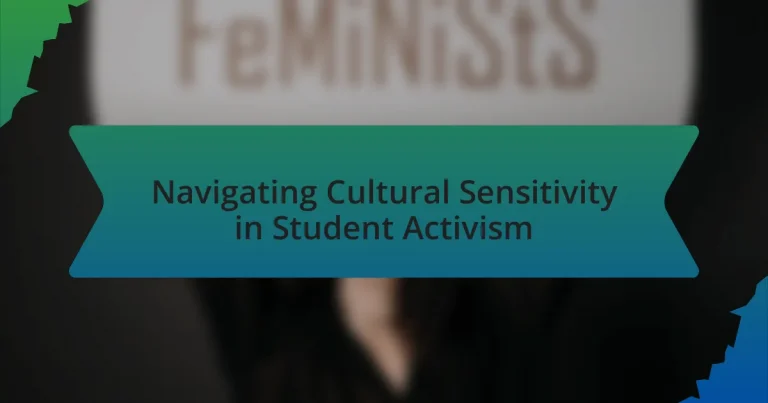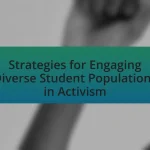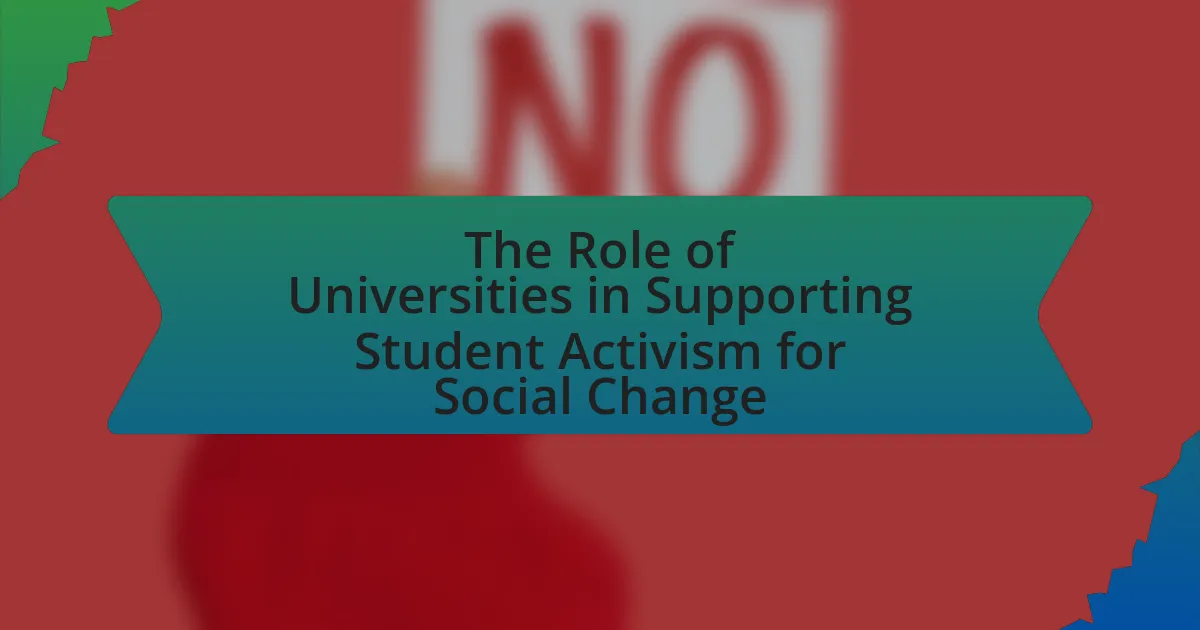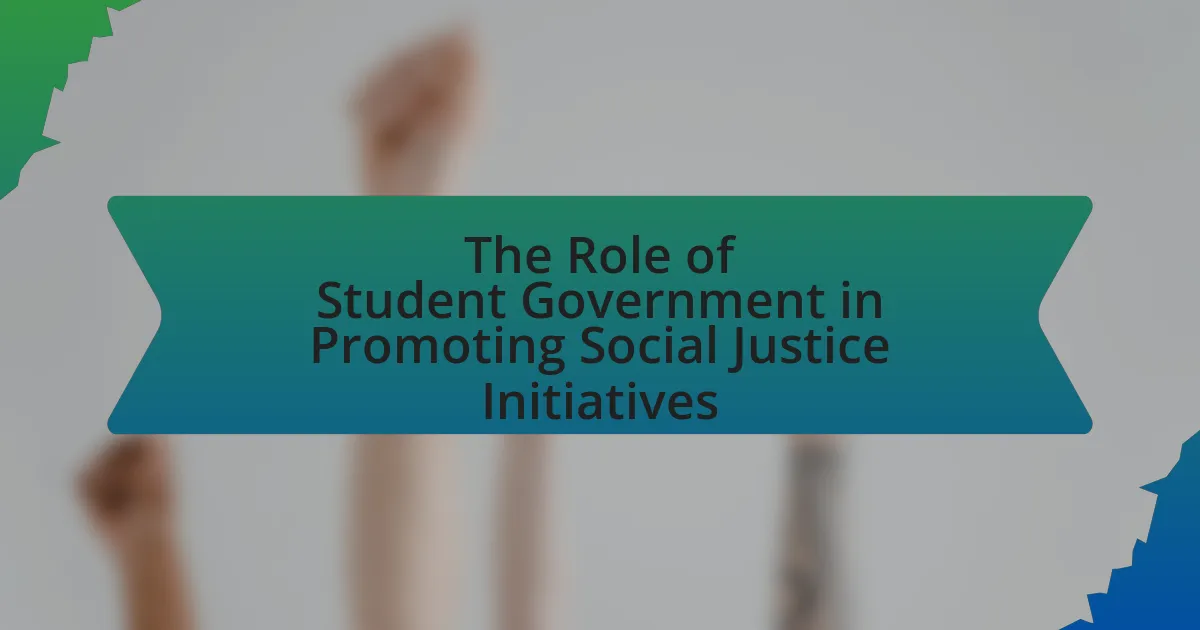Cultural sensitivity in student activism is defined as the awareness and respect for diverse cultural backgrounds within activist movements, which is essential for fostering inclusive dialogue and ensuring marginalized voices are heard. The article explores the importance of cultural sensitivity, its impact on student-led movements, and the consequences of neglecting it, such as misunderstandings and decreased engagement. Key principles include awareness, respect, and understanding, while strategies for promoting cultural sensitivity involve education, open dialogue, and collaboration with diverse groups. The article also addresses challenges students face in maintaining cultural sensitivity and highlights best practices for creating inclusive environments in activism.
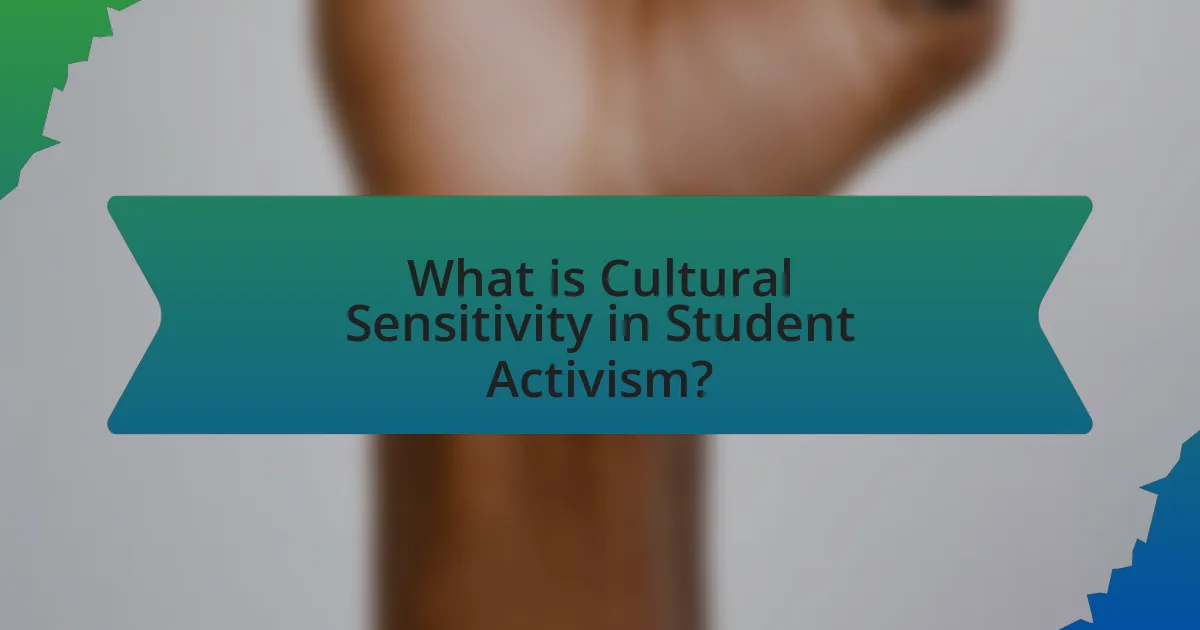
What is Cultural Sensitivity in Student Activism?
Cultural sensitivity in student activism refers to the awareness and respect for diverse cultural backgrounds and perspectives within activist movements. This sensitivity is crucial as it fosters inclusive dialogue, ensuring that the voices of marginalized groups are heard and valued. For instance, research indicates that inclusive activism leads to more effective advocacy outcomes, as it addresses the unique challenges faced by different communities. By prioritizing cultural sensitivity, student activists can create a more equitable environment that promotes understanding and collaboration among diverse groups.
Why is cultural sensitivity important in student activism?
Cultural sensitivity is important in student activism because it fosters inclusivity and understanding among diverse groups. When student activists acknowledge and respect different cultural backgrounds, they create a more unified movement that can effectively address social issues. Research indicates that movements that prioritize cultural sensitivity are more successful in mobilizing support and achieving their goals, as they resonate with a broader audience and avoid alienating potential allies. For instance, the Black Lives Matter movement has emphasized cultural sensitivity to engage various communities, leading to increased participation and awareness of racial injustices.
How does cultural sensitivity impact student-led movements?
Cultural sensitivity significantly enhances the effectiveness of student-led movements by fostering inclusivity and understanding among diverse groups. When students demonstrate awareness and respect for different cultural backgrounds, they create an environment that encourages participation from a broader range of individuals. This inclusivity can lead to more comprehensive discussions and solutions that address the needs of various communities. For instance, research by the American Psychological Association indicates that culturally sensitive approaches in activism can improve group cohesion and mobilization, ultimately leading to more impactful outcomes. By prioritizing cultural sensitivity, student-led movements can better unite individuals around common goals, thereby increasing their overall effectiveness and reach.
What are the consequences of ignoring cultural sensitivity?
Ignoring cultural sensitivity can lead to significant misunderstandings and conflicts within diverse groups. When cultural sensitivity is overlooked, individuals may feel marginalized or disrespected, resulting in decreased participation and engagement in student activism. Research indicates that a lack of cultural awareness can foster an environment of hostility, which undermines collaboration and unity among activists. For instance, a study published in the Journal of Diversity in Higher Education found that organizations lacking cultural sensitivity experienced higher turnover rates and lower overall satisfaction among members. This demonstrates that neglecting cultural sensitivity not only affects interpersonal relationships but also hampers the effectiveness of collective efforts in activism.
What are the key principles of cultural sensitivity?
The key principles of cultural sensitivity include awareness, respect, and understanding of diverse cultural backgrounds. Awareness involves recognizing one’s own cultural biases and the impact they may have on interactions with others. Respect emphasizes valuing different cultural practices and beliefs, fostering an inclusive environment. Understanding requires actively seeking knowledge about other cultures to enhance communication and collaboration. These principles are essential in student activism to ensure that all voices are heard and represented, promoting equity and social justice.
How can understanding diverse backgrounds enhance activism?
Understanding diverse backgrounds enhances activism by fostering inclusivity and broadening perspectives. When activists appreciate various cultural, social, and economic contexts, they can tailor their approaches to address the unique needs and concerns of different communities. This inclusivity leads to more effective strategies, as evidenced by the success of movements like Black Lives Matter, which incorporates voices from various racial and ethnic backgrounds to advocate for systemic change. Research indicates that diverse teams are more innovative and effective in problem-solving, as highlighted in a study by McKinsey & Company, which found that organizations with diverse leadership are 35% more likely to outperform their peers. Thus, understanding diverse backgrounds not only enriches the dialogue within activism but also enhances its overall impact.
What role does empathy play in cultural sensitivity?
Empathy is crucial in fostering cultural sensitivity as it enables individuals to understand and appreciate diverse perspectives and experiences. By actively engaging with the feelings and viewpoints of others, empathy helps to break down barriers and reduce biases, facilitating more respectful and meaningful interactions across cultures. Research indicates that empathetic engagement can lead to improved communication and collaboration in multicultural settings, which is essential for effective student activism. For instance, a study published in the Journal of Social Issues highlights that empathy enhances intercultural competence, allowing individuals to navigate complex social dynamics with greater awareness and respect.
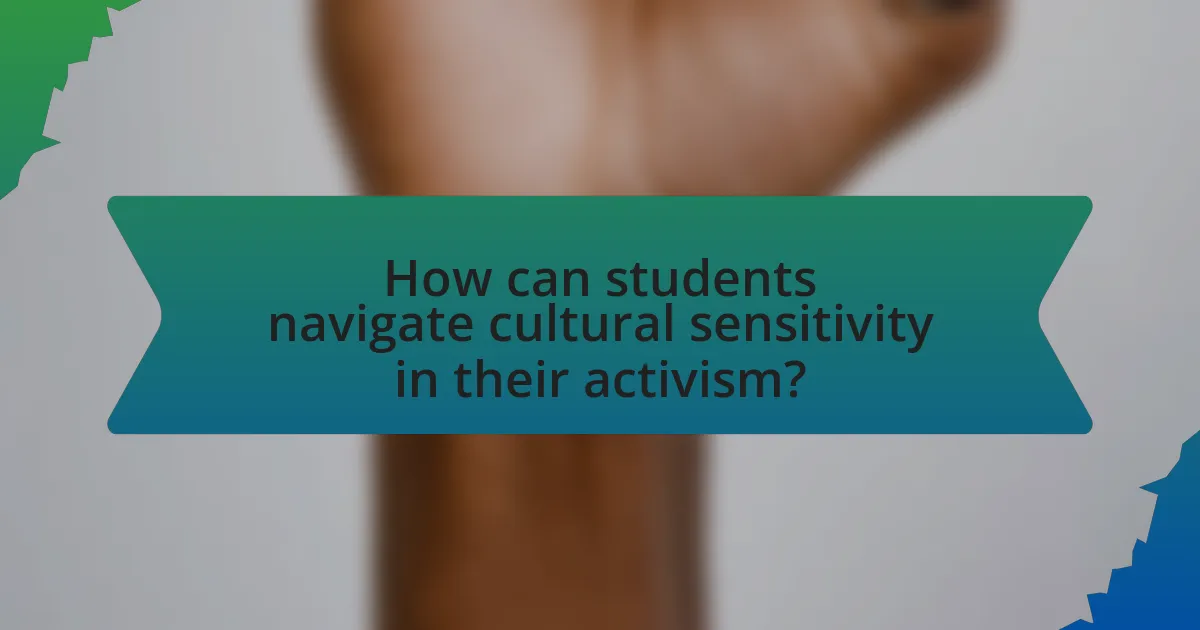
How can students navigate cultural sensitivity in their activism?
Students can navigate cultural sensitivity in their activism by actively educating themselves about the diverse cultures and perspectives within their communities. This involves engaging in open dialogues with individuals from different backgrounds, attending workshops on cultural competence, and researching historical contexts that shape current social issues. For instance, a study by the American Psychological Association highlights that understanding cultural nuances can enhance empathy and reduce misunderstandings in activism. By prioritizing inclusivity and respect, students can foster a more effective and harmonious activist environment.
What strategies can students employ to promote cultural sensitivity?
Students can promote cultural sensitivity by actively engaging in diverse cultural experiences and education. This can be achieved through participating in cultural exchange programs, attending workshops on cultural awareness, and incorporating multicultural perspectives into their studies. Research indicates that exposure to different cultures enhances empathy and understanding, which are crucial for fostering sensitivity. For instance, a study published in the Journal of Cross-Cultural Psychology found that individuals who engage with diverse groups demonstrate improved intercultural competence. By implementing these strategies, students can effectively contribute to a more inclusive and respectful environment.
How can students educate themselves about different cultures?
Students can educate themselves about different cultures by actively engaging in cultural exchange programs, attending workshops, and participating in community events that celebrate diversity. These activities provide firsthand experiences and insights into various cultural practices and beliefs. For instance, research from the American Council on Education indicates that students who participate in study abroad programs report increased cultural awareness and sensitivity. Additionally, reading literature from diverse authors and consuming media from different cultures can enhance understanding and appreciation of cultural nuances.
What are effective communication techniques for diverse groups?
Effective communication techniques for diverse groups include active listening, using clear and inclusive language, and fostering an environment of respect and openness. Active listening ensures that all voices are heard and valued, which is crucial in diverse settings where cultural differences may affect communication styles. Using clear and inclusive language helps to avoid misunderstandings and ensures that everyone can engage meaningfully in discussions. Fostering an environment of respect and openness encourages participants to share their perspectives without fear of judgment, promoting a collaborative atmosphere. These techniques are supported by research indicating that effective communication in diverse groups enhances group cohesion and improves outcomes in collaborative efforts.
How can collaboration with diverse groups enhance activism?
Collaboration with diverse groups enhances activism by broadening perspectives and increasing the reach of advocacy efforts. When activists unite with individuals from various backgrounds, they gain access to a wider array of experiences, ideas, and strategies, which can lead to more innovative solutions to social issues. For instance, research by the American Psychological Association indicates that diverse teams are more effective at problem-solving due to their varied viewpoints. This diversity fosters inclusivity, ensuring that the needs and concerns of different communities are represented, ultimately leading to more impactful and sustainable activism.
What are the benefits of inclusive coalitions in activism?
Inclusive coalitions in activism enhance the effectiveness and reach of movements by bringing together diverse perspectives and experiences. This diversity fosters innovative solutions to complex social issues, as different backgrounds contribute unique insights that can address the needs of various communities. Research indicates that inclusive coalitions can lead to increased participation and engagement, as individuals feel represented and valued within the movement. For instance, a study by the Center for American Progress found that diverse coalitions are more likely to mobilize broader support and achieve policy changes, demonstrating the tangible benefits of inclusivity in activism.
How can students ensure all voices are heard in their initiatives?
Students can ensure all voices are heard in their initiatives by actively engaging diverse groups through inclusive practices. This involves conducting surveys, holding open forums, and creating focus groups that represent various demographics within the student body. Research indicates that initiatives with diverse input lead to more effective outcomes, as seen in the study “The Importance of Diverse Perspectives in Student Leadership” published in the Journal of Student Affairs Research and Practice, which highlights that inclusive decision-making processes enhance community engagement and satisfaction. By implementing these strategies, students can foster an environment where every voice contributes to the initiative’s direction and success.
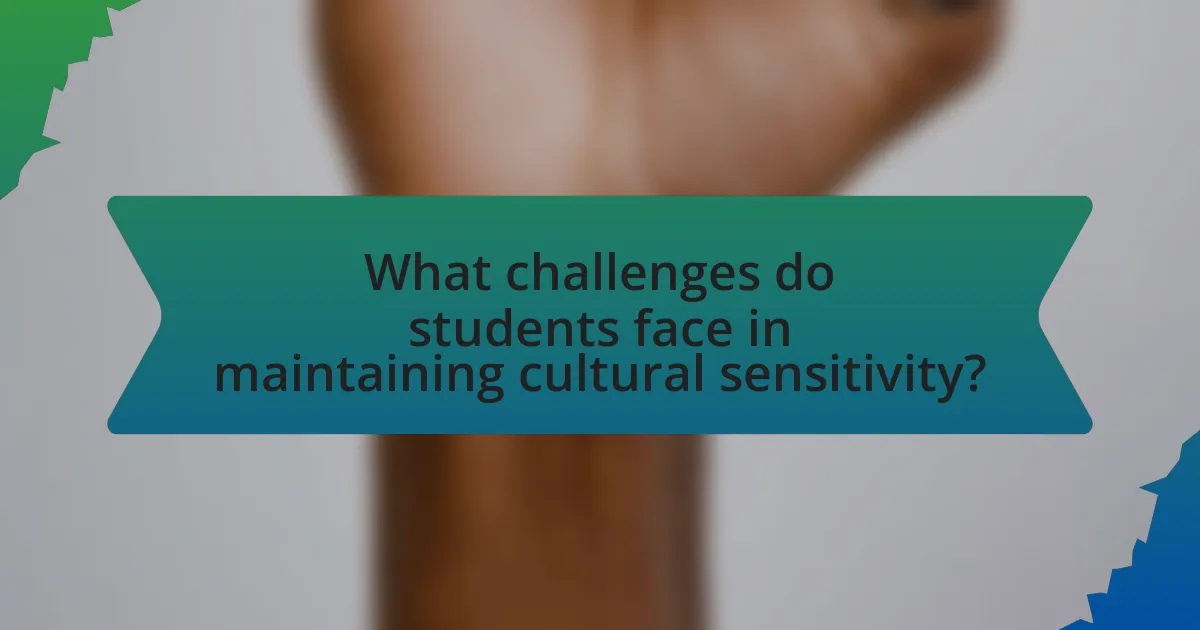
What challenges do students face in maintaining cultural sensitivity?
Students face several challenges in maintaining cultural sensitivity, primarily due to a lack of awareness and understanding of diverse cultural backgrounds. This lack of knowledge can lead to unintentional microaggressions or cultural appropriation, which can alienate peers and hinder effective communication. Additionally, students may struggle with differing cultural norms and values, making it difficult to navigate discussions around sensitive topics. Research indicates that educational environments often lack comprehensive training on cultural competence, which further exacerbates these challenges. For instance, a study by the American Council on Education found that only 25% of institutions provide adequate training on diversity and inclusion, highlighting a significant gap in resources that could help students develop cultural sensitivity.
What common pitfalls should students avoid in activism?
Students should avoid the pitfall of cultural appropriation in activism. This occurs when individuals adopt elements of a marginalized culture without understanding or respecting its significance, which can lead to misrepresentation and offense. For instance, using symbols or practices from a culture in a superficial manner can alienate the very communities activists aim to support. Additionally, students should steer clear of tokenism, where they include individuals from diverse backgrounds only for appearances rather than valuing their contributions. This can undermine genuine representation and dilute the message of the activism. Lastly, students must avoid echo chambers by engaging only with like-minded individuals, which limits perspectives and hinders effective dialogue. Engaging with diverse viewpoints fosters a more comprehensive understanding of issues and strengthens activism efforts.
How can stereotypes hinder effective activism?
Stereotypes can hinder effective activism by creating misconceptions that limit understanding and engagement with the issues at hand. When activists are viewed through the lens of stereotypes, their messages may be dismissed or misinterpreted, reducing the impact of their efforts. For instance, research indicates that stereotypes can lead to a lack of empathy and support from potential allies, as seen in studies where individuals from marginalized groups faced barriers in gaining support due to preconceived notions about their capabilities or motivations. This disconnect can result in a fragmented movement, where the voices of those most affected by the issues are overshadowed or ignored, ultimately undermining the goals of the activism.
What are the risks of cultural appropriation in student movements?
Cultural appropriation in student movements poses significant risks, including the potential for reinforcing stereotypes and marginalizing the voices of the cultures being appropriated. When students adopt elements from another culture without understanding their significance, it can lead to misrepresentation and trivialization of those cultural practices. For instance, using traditional attire as fashion statements can diminish their cultural importance and perpetuate harmful stereotypes. Additionally, cultural appropriation can create divisions within student communities, as marginalized groups may feel disrespected or excluded, undermining solidarity and collaboration in activism. This dynamic can hinder the effectiveness of movements aimed at promoting inclusivity and social justice, as it shifts focus away from the original issues at hand.
How can students address and overcome these challenges?
Students can address and overcome challenges related to cultural sensitivity in activism by engaging in open dialogues and educating themselves about diverse perspectives. By participating in workshops and discussions that focus on cultural awareness, students can develop a deeper understanding of the issues faced by different communities. Research indicates that inclusive educational environments enhance empathy and reduce biases, which is crucial for effective activism. Additionally, forming coalitions with diverse student groups allows for shared experiences and collaborative problem-solving, fostering a more inclusive approach to activism.
What resources are available for students seeking guidance?
Students seeking guidance can access various resources, including counseling services, academic advisors, peer support groups, and online platforms focused on cultural sensitivity. Counseling services provide personalized support for emotional and psychological challenges, while academic advisors offer guidance on educational pathways and resources. Peer support groups foster community and shared experiences, allowing students to discuss cultural sensitivity in activism. Online platforms, such as forums and educational websites, provide articles, webinars, and discussion groups that focus on navigating cultural sensitivity in student activism, enhancing understanding and skills in this area.
How can peer feedback improve cultural sensitivity in activism?
Peer feedback can improve cultural sensitivity in activism by fostering open dialogue and diverse perspectives among participants. This collaborative process allows individuals to share their experiences and insights, which can highlight cultural nuances that may otherwise be overlooked. Research indicates that peer feedback encourages critical reflection, enabling activists to recognize and address their biases, thus enhancing their understanding of different cultural contexts. For instance, a study published in the Journal of Social Issues found that peer discussions significantly increased participants’ awareness of cultural differences and improved their ability to engage respectfully with various communities.
What are best practices for fostering cultural sensitivity in student activism?
Best practices for fostering cultural sensitivity in student activism include promoting inclusive dialogue, educating participants about diverse cultures, and encouraging collaboration with marginalized communities. Inclusive dialogue ensures that all voices are heard, which fosters understanding and respect among students from different backgrounds. Education about diverse cultures can be achieved through workshops, seminars, and resource sharing, helping students recognize and appreciate cultural differences. Collaboration with marginalized communities allows activists to understand their specific needs and perspectives, ensuring that activism is relevant and respectful. These practices are supported by research indicating that culturally sensitive approaches in activism lead to more effective and equitable outcomes.
How can students create inclusive environments for activism?
Students can create inclusive environments for activism by actively engaging diverse voices and perspectives in their initiatives. This can be achieved through organizing workshops that focus on cultural sensitivity, ensuring representation from various demographic groups, and fostering open dialogues that encourage participation from all community members. Research indicates that inclusive activism not only enhances group cohesion but also leads to more effective advocacy outcomes, as diverse teams are better at problem-solving and innovation. For instance, a study by the Harvard Business Review found that diverse teams outperform homogeneous ones by 35% in decision-making processes. By implementing these strategies, students can cultivate a more inclusive atmosphere that empowers all individuals to contribute to activism efforts.
What role do workshops and training play in promoting cultural sensitivity?
Workshops and training play a crucial role in promoting cultural sensitivity by providing structured environments for individuals to learn about diverse cultures and perspectives. These educational sessions facilitate open dialogue, allowing participants to confront biases and develop empathy towards different cultural experiences. Research indicates that organizations implementing cultural sensitivity training see improved interpersonal relationships and reduced conflicts, as evidenced by a study published in the Journal of Diversity in Higher Education, which found that 75% of participants reported increased awareness of cultural differences after attending such workshops. This demonstrates that targeted training effectively enhances understanding and respect for cultural diversity, essential for fostering inclusive environments in student activism.
